| Please access the following URL if you want to secure using SSL. All pages in the site will be secure pages. |
https://secure02.blue.shared-server.net/www.fish-food.co.jp/message english 8.2024.html |
Welcome to FISH FOOD TIMES
Aug. 2024 issue No.248

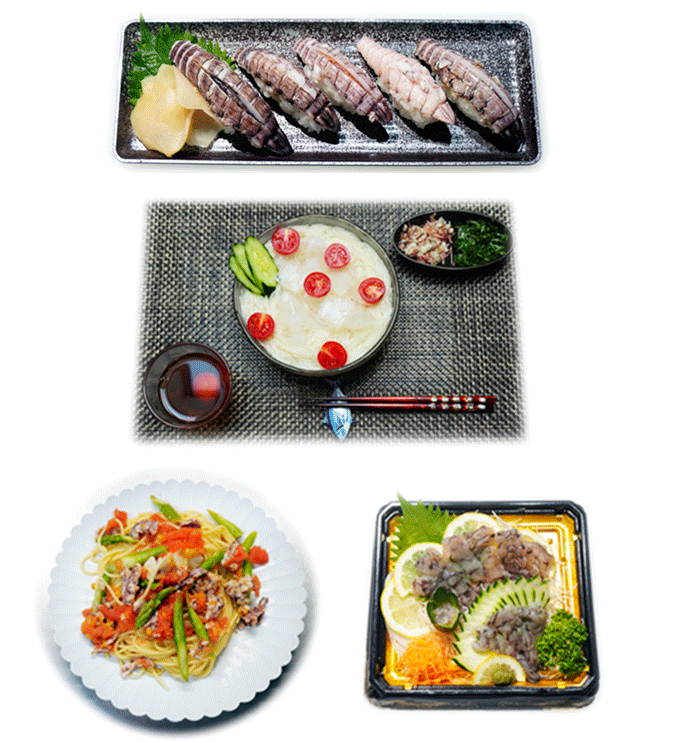
Squilla
I've been avoiding it, but...
It was late July, and with no particular idea in mind about what to cover as the theme for the August issue of FISH FOOD TIMES, I went to the fish section of my usual go-to store. However, on that day, I felt that I couldn't find any fish suitable for the theme of FISH FOOD TIMES in the store's selection of raw fish.
When I write an article for FISH FOOD TIMES, I basically try to find a fish that has not been covered in any previous issues, but with 248 issues, it is really difficult to achieve this goal. Of course, there are a few fish that I have covered several times in the past, but in a sense they are very popular large commercial products and therefore species that I can write articles about from various perspectives, and there are not that many such fish.
Common sense would suggest that there is no shortage of fish to choose from, since there are countless fish in the oceans and rivers of the world. However, ornamental fish such as tropical fish and goldfish, and rare and unusual fish, which cannot be calculated commercially by the "fish retailers" that FISH FOOD TIMES assumes as its readers, are not included. If we start from this premise, the target fish are naturally limited, and this becomes more and more of a headache with each passing time.
"Well, what should I do?" I was standing there in the fish section, wondering, when the always kind fish manager offered me a recommendation: "How about this one this time? It has roe."
It was squilla. I knew that I had never written an article about squilla before, but I had no experience or knowledge that could imagine how to turn it into a story that has a beginning, development, turn and conclusion. So, I had been avoiding writing about squilla until now.
So I asked the fish section manager who recommended squilla, "What is the best way to eat it?" and he replied, "In somen noodle soup." This suggestion was completely unexpected and truly surprising. However, I instantly found it interesting. Because summer is finally in full swing, and I had just eaten chilled somen just a few days ago, I felt that fish was the perfect theme for the August issue.
Not having the slightest idea of what the August issue would contain, I thought that I would be able to manage it somehow, and so I purchased 10 female squilla with roes and 15 males, which were still fresh enough to carry them, although they were not live squilla with their legs flapping about.
Squilla is similar to shrimp but not the same
Below is the squilla I purchased this time.
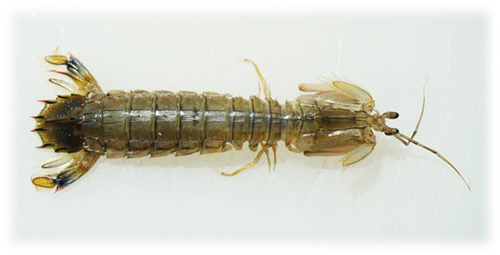
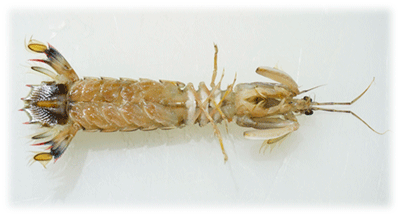
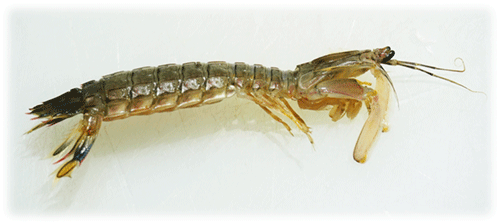
The difference between male and female squilla can be seen in this part of the image below.
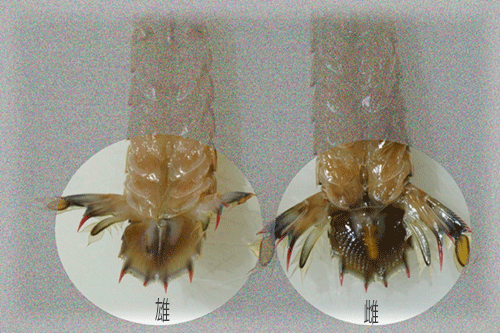
Females have a slightly elongated yellow area in the center of the inside of the telson, and the color of this area indicates whether they are pregnant.
This was also something I learned for the first time about squilla. When you turn a live squilla over, you can see that the 10 flat legs moving on its abdomen are swimming legs that it uses to swim in the sea, just as I had imagined. However, I was a bit surprised to learn that the countless thin, flimsy organs attached to those legs are actually gills.

This part is very different from shrimp, which are very similar to squilla. Although they look similar to shrimp, which are the same crustacean, they are very distantly related, with squilla belonging to the order Stomatopoda and shrimp belonging to the order Decapoda.
By the way, the image below shows a crustacean called syaku (a name used in the Ariake region of Kumamoto) which is a little confusingly similar to squilla (official Japanese name shako). In the Chikugo region of Fukuoka it is called majyaku, and its official Japanese name is anajyako. This anajyako(Japanese mud shrimp) is a member of the decapod crustacean order, suborder shrimp, so it is not a member of the squilla family but a member of the shrimp family.
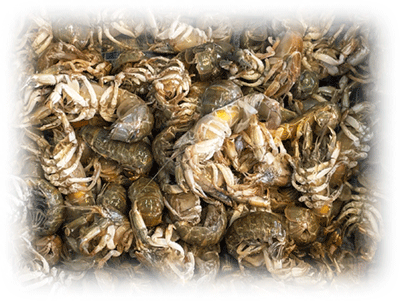
The season for Japanese mud shrimp is from May to July. Squilla is also in season around the same time, and by August the shrimp are pregnant and ready to spawn. It is said that squilla are "tasty when the wheat ears ripen," so you could say that they are the polar opposite of the skinny, unappetizing wild sea bream that is caught in the same season and known as "straw barley snapper," which is caught after spawning.
I had never tried the squilla with roe that was recommended to me, which is different from regular squilla, so I gradually became interested in what this seasonal, slightly more expensive squilla with roe would taste like.
squillaの刺身
The only way to eat squilla that I know of is boiled squilla nigiri sushi, and I have never had it cooked any other way. From the beginning, I only knew that squilla was something that was boiled and eaten as nigiri sushi, and since I had no other knowledge of it, I thought that even if it was taken up as a theme for FISH FOOD TIMES, there would be no way it could be developed into something interesting, so I avoided it.
However, since I decided to work with squilla this time, I decided to start by trying raw squilla sashimi, rather than the typical boiled squilla. I knew that it was difficult to remove the shells of raw squilla, but when I actually tried it, it was so difficult that I gave up. So, as a countermeasure, I decided to freeze them and remove the shells when they were half-thawed. I was successful in doing this, as shown in the image below.
| Raw squilla sashimi process | |
|---|---|
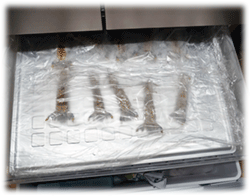 |
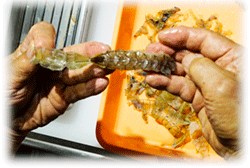 |
| 1,Place plastic wrap on an aluminum plate for quick freezing, arrange the squilla on top, and then cover with plastic wrap. | 8,Once the sides have been trimmed, the dorsal shell is removed using fingers, working from the head towards the telson. |
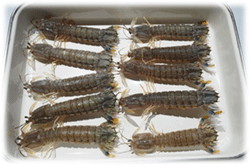 |
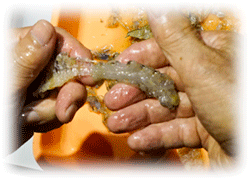 |
| 2,After the specified freezing period has finished, transfer the squilla from the aluminum plate to a shallow tray. | 9,Next, remove the abdominal shell with your fingers from the telson side towards the head side. |
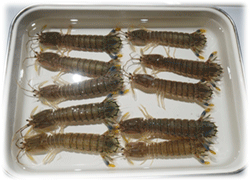 |
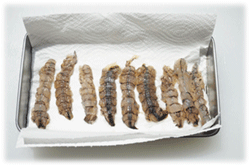 |
| 3,Put water in a tray and thaw only the surface of the squilla. | 10、Raw squilla with the shell removed. |
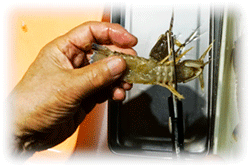 |
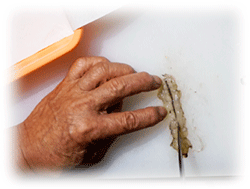 |
| 4,Cut off the heads of the semi-thawed squilla with kitchen scissors. | 11,Turn the squilla ventral side up and use the tip of a Yanagiba knife to make a shallow incision in the membrane surrounding the visceral area. |
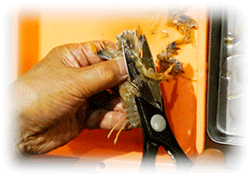 |
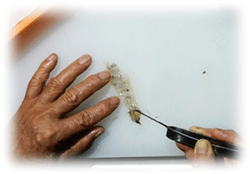 |
| 5,Use scissors to cut off the legs at the neck and the part where the dorsal and abdominal shells of the body are joined in the direction of the telson. | 12,Pull up, separate and remove the internal organs using a bone removal tool. |
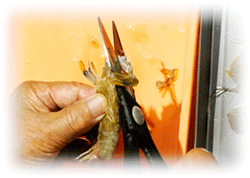 |
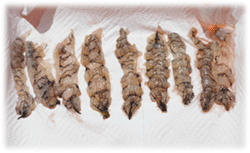 |
| 6,Cut the telson using scissors at a diagonal angle. | 13,Squilla after the process of removing the internal organs. |
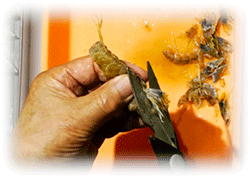 |
 |
| 7,Cut diagonally with the scissors so that the telson forms a triangle, then cut through the part of the body where the dorsal and ventral shells join, and through the legs towards the head. | 14,Fold the squilla head side in half and arrange one squilla at a time to complete the dish. I put the squilla claws in an ashirai container made from a cucumber. |
This is my first time making squilla sashimi, and my first time eating it. So, what did I think of the taste? My guess is that very few of our readers have ever eaten squilla sashimi. Based on the shape of the squilla, I predicted that it would be similar to the same crustacean as japanese tiger prawn sashimi. When they ate it, they found that it was "not as sweet as japanese tiger prawn, and had a relatively muted flavor.'' This seems to be similar to the difference in taste that you feel when comparing ordinary boiled japanese tiger prawn nigiri sushi and boiled squilla nigiri sushi. However, it had absolutely no chewy texture like Japanese tiger prawn sashimi, so I felt that there was a big difference in that respect.
Different ways of boiling squilla
Next is boiled squilla. In fact, I found that the somen noodle soup for squilla is quite different from the method used to make regular boiled squilla, so I made boiled squilla in two different ways. After trying both methods myself, I felt something close to awe: "Just one squilla can produce such a so deep in flavor."
First, the generally well-known method of making boiled squilla was as follows.
| The working process of boiled squilla | |
|---|---|
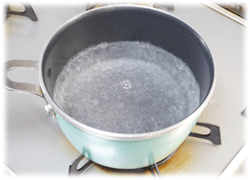 |
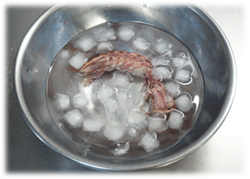 |
| 1,Bring water to a boil with a pinch of salt. | 4,After boiling for a certain amount of time, put it in ice water to cool it down. |
 |
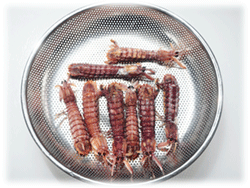 |
| 2,Add squilla to boiling water. | 5,Drain the squilla thoroughly after cooling it in ice water. |
 |
 |
| 3,Boil for around 3 minutes. | 6,Drain the water and the boiled squilla is completed. |
After making this amount of boiled squilla, I had some leftover broth, like the one in the image below. I decided to use this for another dish, rather than making somen noodle soup.
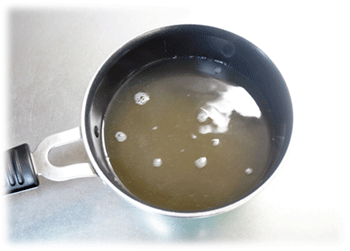
I made somen tsuyu by making a seasoned broth, adding squilla, and bringing the water from cold to boiling, as shown in the image below. The balance of the seasonings is water:soy sauce:mirin = 7:1:1.

Once the broth has boiled, turn off the heat and leave the squilla in the pot for a short while before removing it. Do not put squilla in ice water, let it cool naturally.

This photo shows the squilla being removed from the broth and cooled. Its appearance was no different from that of squilla cooked in boiling water, and even after removing the shells and making nigiri sushi, it was almost impossible to tell the difference just by looking at it.
Although the methods for making boiled squilla are completely different, I didn't have any trouble removing the shells with either method. After trying different boiling times for squilla, I can say that boiling squilla for about 3 minutes is basically enough, and boiling for more than 5 minutes makes it difficult to remove the shells.
So deep in flavor, made with the broth from boiled squilla
I made squilla in two different ways, so I ended up with two different broths. So, one of the reasons for choosing this theme was to make "somen soup'' and use it to make our own style of chilled somen. The other was to use the broth to cook squilla soup pasta.
First, let me show you how to make boiled squilla soup pasta.
| boiled squilla soup pasta | |
|---|---|
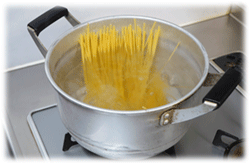 |
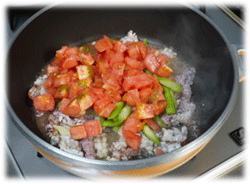 |
| 1,Add 200g of pasta noodles to the boiling water. | 6,Peel off fresh tomatoes in hot water, diced them and add them to the pot. |
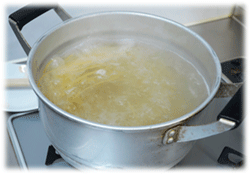 |
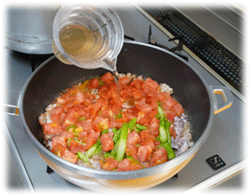 |
| 2,Boil while checking the consistency. | 7,Add the broth used to make the boiled squilla. |
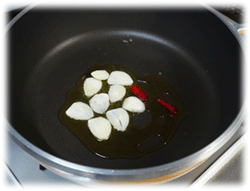 |
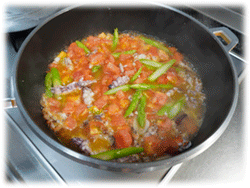 |
| 3,Add the garlic and red chili pepper to a frying pan with olive oil and cook slowly over low heat, transferring the aroma to the olive oil. | 8,Wait until the vegetables are cooked. |
 |
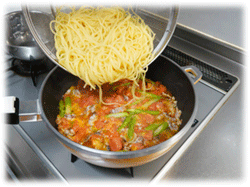 |
| 4,Add boiled squilla, chopped to a suitable size, to the frying pan. | 9,Add pasta noodles. |
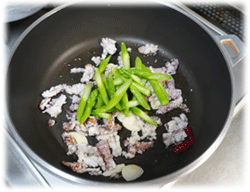 |
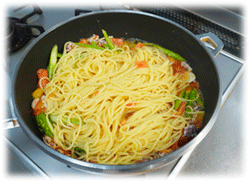 |
| 5,Add boiled asparagus cut into around 3 cm pieces. | 10、Mix pasta noodles and ingredients together to finish. |
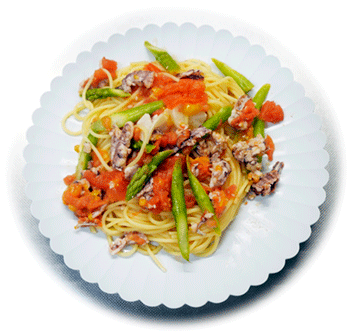 |
|
| The boiled squilla soup pasta is complete. | |
The resulting boiled squilla soup pasta tasted better than I expected, and was at the highest level. In this dish, I was able to enjoy the truly natural taste, which had nothing to do with artificial flavoring. The key to this amazing flavor was the squilla broth that was added as a soup, and I felt like licking up the liquid left on the plate.
Next up, it's time to make "Chilled somen noodles in squilla sauce,"which is what inspired me to make this month's issue about squilla. I actually ate the boiled squilla soup pasta for lunch on the second day, and the "Chilled somen noodles in squilla sauce" for lunch on the third day, in two separate meals. Otherwise, no matter how delicious the food is, we will not be able to correctly judge the taste of the food when we are full.
Below is the process for making chilled somen noodles using squilla broth.
| the process for making chilled somen noodles using squilla broth | |
|---|---|
 |
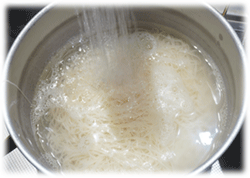 |
| 1,Add the somen noodles to the boiling water. | 5,Add cold water to the somen noodles and rub them while cooling them. |
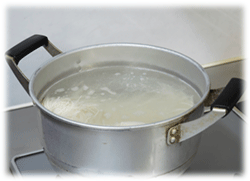 |
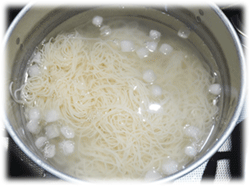 |
| 2,Stir slowly with cooking chopsticks to prevent the noodles from sticking to each other, and adjust the heat. | 6,Add ice to further chill the somen noodles. |
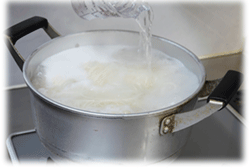 |
 |
| 3,Add Bikkuri water to prevent overflow and to adjust the water temperature. | 7,Roll the boiled somen noodles and place them on a plate. |
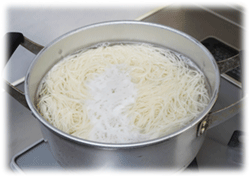 |
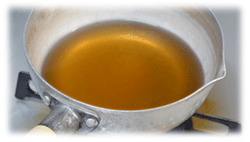 |
| 4,It will be boiled in about 2 minutes. | 8、The broth from boiling the squilla in cold seasoning liquid is used as the soup for the somen noodles. |
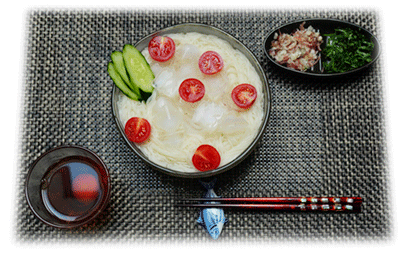 |
|
| 9,Chilled somen noodles using squilla broth | |
Looking at the image of chilled somen serving above, I think some of you may be thinking, "What on earth is this...?" This is our home-style chilled somen noodles; the small bowl on the top right contains chopped myoga and shiso leaves as condiments, and the soup bowl contains not only the squilla broth but also raw egg yolk. Also, somen noodles are placed in a glass bowl with chilled water and topped with a few ice cubes, cucumber slices, and cherry tomatoes.
In this way, we put the yolk of a raw egg into the somen noodle soup, add some seasonings, mix them together, and slurp up the somen noodles. This is our home-style chilled somen noodles. Especially in the case of this year's extreme heat, the yolk of the raw egg is the key to overcoming summer fatigue. Since one yolk is not enough for me, I usually use two or more raw eggs.
Until now, my family has used commercially available stocks made from kelp, bonito, and ago (dried flying fish) to make somen noodle soup, but this time I discovered squilla broth and was truly surprised at how delicious it was.
I had been impressed by the deliciousness of the boiled squilla soup pasta I had the day before, so I was expecting the boiled squilla somen soup to be delicious as well, but not only did it not live up to those expectations, it was even more delicious.
Even when I adjust commercially available dashi soup to my own taste, the spiciness of the soy sauce always remains, and I don't feel like drinking the soup to the last drop. However, with squilla broth somen soup, I want to drink it all up, and I actually did drink it all up, to the last drop. To describe the amazing deliciousness that makes me feel this way, and I apologize for using this expression so many times, it is "so deep in flavor."
I had lived a long life without ever knowing this taste, but this experience made me realize that there is a world out there where "Only those in the know will apriciate."
Squilla nigiri sushi with roe
Well, I have now gotten to the core of this month's theme, but since I have not yet mentioned squilla with roe, I would like to introduce the process of making nigiri sushi using squilla with roe.
| Working process of squilla nigiri sushi with roe | |
|---|---|
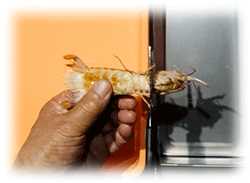 |
 |
| 1,Cut off the heads of the boiled squilla with roe using scissors. | 7,Remove the abdominal shell with your fingers from the telson toward the head. |
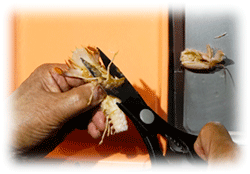 |
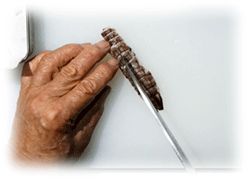 |
| 2,Cut off the legs attached to the neck and the part where the dorsal and abdominal shells of the body are connected towards the telson. | 8,Make a shallow vertical cut in the centre of the back of the squilla with roe using a yanagiba knife. |
 |
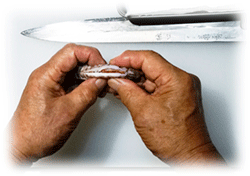 |
| 3,Cut off the telson at a diagonal angle. | 9,If you open the cut on the back of a squilla with roe with your fingers, you can see a little bit of red roe called katsubushi. |
 |
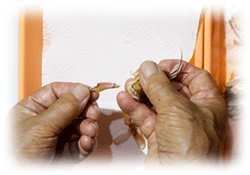 |
| 4,Cut the telson into a triangular shape. | 10、Using your fingers, remove the part called the supplementary leg that remains on the cut off head from the base. |
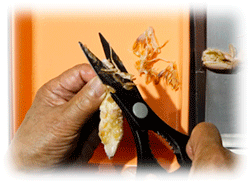 |
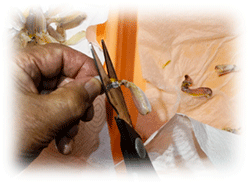 |
| 5,Cut off the part of the body where the dorsal and ventral shells join and the legs at the neck. | 11,Cut the base end of the supplementary leg with scissors and push out the muscle inside with your fingers. |
 |
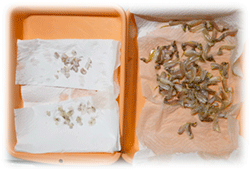 |
| 6,Using your fingers, remove the back shell from the head towards the telson. | 12,What is in the left container is a small muscle called the squilla claw taken out from the supplementary leg. |
 |
|
| 13,All five are squilla with roe. However, I decided to stuff squilla claws into the cut of the back of two of them. | |
This was my first time eating squilla nigiri sushi with roe. As for what the roe tasted like, it didn't have any special taste or smell, and its presence was very subtle and modest.
In addition, the muscle part inside the supplementary leg of the squilla, called squilla claws, is also extremely small, and although there were more than five or six of them stuffed into the split part of the squilla nigiri sushi with roe, they also did not feel very present. Squilla claws is generally used in gunkanmaki, but I decided not to do so this time for quantitative reasons, and perhaps this has diluted the presence of squilla claws by my own hand.
I still have a lot to learn
When I finished the work related to the August issue, I found that the content was very interesting to me. It made me realize that squilla, an object that I had avoided getting involved with because I didn't know much about it, actually had great potential in many ways.
I truly felt that, "Even at this age, I still have a lot to learn.''
What particularly impressed me was the amazing taste of the broth. Whether it was the Western-style "boiled squilla soup pasta" or the Japanese-style "chilled somen noodles using squilla broth," I felt that both had "an impressive level of flavor in the broth."
Due to my own profession, I have eaten fish dishes above all else, not only in Japan, but also in the number of foreign countries I have visited, and have had many experiences eating fish dishes. In that respect, I am proud that ``I have eaten a lot of different kinds of fish in various forms, so I probably won't be left behind.'' This author felt that the deliciousness of squilla broth should rank among the top when compared to other fish.
The flavor of the boiled squilla itself is probably not particularly high level, but the broth is exceptionally tasty. If I had to put this into words, I think the best way to describe it would be "so deep in flavor."
I just hope that I will have more encounters with fish like this one in the future.
| Please access the following URL if you want to secure using SSL. All pages in the site will be secure pages. |
https://secure02.blue.shared-server.net/www.fish-food.co.jp/message english 8.2024.html |
An opinion and the communication are to iinfo@fish food times
Date of updating 1 Aug. 2024
